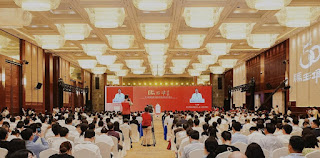Hunan Museum
This year marks the 50th anniversary of the archaeological excavation of Mawangdui Han Tombs. To fully showcase the fruitful results in the preservation, research, and utilization of the archaeological excavation of Mawangdui Han Tombs and raise the global clout of Chinese civilization, the opening ceremony of the international academic seminar kicked off in Changsha on the morning of August 18. Hosted by the People's Government of Hunan Province, the ceremony was undertaken by the Publicity Department of the Hunan Provincial Committee, the Hunan Provincial Department of Culture and Tourism, and the Cultural Heritage of Hunan, with other participating units including the Hunan Museum. Mao Weiming, Deputy Secretary of the Hunan Provincial Committee and Provincial Governor, and Li Qun, Deputy Minister of the Ministry of Culture and Tourism of the People's Republic of China and Director of the National Cultural Heritage Administration, delivered speeches at the opening ceremony. Present at the event were leaders including Yang Haodong, a member of the Standing Committee of the Hunan Provincial Committee, and Minister of the Publicity Department of the Hunan Provincial Committee.
At the opening ceremony, the China Central Newsreel & Documentary Film Studio (Group) donated academic HD video footage of the Mawangdui Han Tombs archaeological excavation sites to the Hunan Museum. The bamboo slips and silk manuscripts unearthed from the Mawangdui Han Tombs and textiles from Han Tomb No.1, along with new research findings on these artifacts, were unveiled. The documentary Mawangdui's Immortal Years, which captures the excavation, preservation, research, and exhibition of Mawangdui Han Tombs, also premiered. Additionally, the Hunan Museum signed agreements with six institutions, including the Hong Kong University of Science and Technology and the Dunhuang Academy, to launch collaborative interdisciplinary projects.
For half a century, generations of dedicated guardians have poured immense effort and wisdom into preserving and studying the Mawangdui Han Tombs, leading to significant research achievements. A comprehensive inventory of the artifacts unearthed from the tomb revealed a total of 26,937 items. The human remains specimens, including the well-preserved body of Lady Xin Zhui, have been effectively safeguarded through a three-tiered protection approach at the holistic, cellular, and molecular levels. This method has successfully mitigated the dissolution of proteins and the loss of calcium ions in the bones. Other artifacts, such as silk manuscripts, textiles, and lacquer and wooden artifacts, have also received fundamental and highly effective preservation. To date, 948 artifacts have been captured in high-resolution digital formats, encompassing 7,779 images and 285 3D models, laying the foundation for the Mawangdui Han Tombs artifact knowledge base.
The future goal is to achieve 100% digitization, including all fragments, to create a comprehensive knowledge graph of the Mawangdui Han Tombs artifacts. The 2-day academic seminar, with its theme focused on "Mawangdui Han Tomb Relics, Han Culture, and Contemporary China", consists of four sub-seminars devoted to Han Dynasty archaeology and Sino-foreign cultural exchange research, Han Dynasty art and ideological history research, Han Dynasty bamboo slips and silk manuscripts research, and Han Dynasty medical research respectively. The participating experts and scholars shared and discussed innovative ideas, perspectives, and achievements in the preservation and inheritance of cultural relics.
The international academic seminar, arousing wide concern at home and abroad, is attended by more than 300 experts and scholars from over 100 universities, research institutes, and museums from 8 countries. The Greek Ministry of Culture and Sports, and the Representative Office of UNESCO in China, among other institutions, as well as renowned scholars, sent congratulatory letters and videos to the event.
The Mawangdui Han Tombs marks where Li Cang, the Chancellor of the Changsha Kingdom during the Western Han Dynasty, and his three family members were buried. The tomb is renowned for the remarkable preservation of Lady Xin Zhui (the wife of Li Cang), a female corpse that has remained intact for over two millennia, the discovery of an ancient Chinese gown as thin as a cicada's wing, and over 130,000 words of silk manuscripts, some containing lost texts. It has gained wide recognition as one of the most significant archaeological discoveries of the 20th century, not only in China but globally.
Source: Hunan Museum


No comments:
Post a Comment